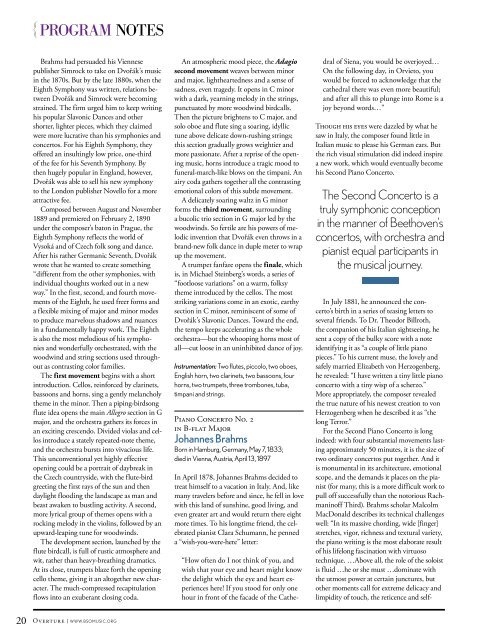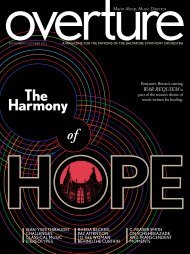November–December 2012 - Baltimore magazine
November–December 2012 - Baltimore magazine
November–December 2012 - Baltimore magazine
You also want an ePaper? Increase the reach of your titles
YUMPU automatically turns print PDFs into web optimized ePapers that Google loves.
{ Program notes<br />
Brahms had persuaded his Viennese<br />
publisher Simrock to take on Dvořák’s music<br />
in the 1870s. But by the late 1880s, when the<br />
Eighth Symphony was written, relations between<br />
Dvořák and Simrock were becoming<br />
strained. The firm urged him to keep writing<br />
his popular Slavonic Dances and other<br />
shorter, lighter pieces, which they claimed<br />
were more lucrative than his symphonies and<br />
concertos. For his Eighth Symphony, they<br />
offered an insultingly low price, one-third<br />
of the fee for his Seventh Symphony. By<br />
then hugely popular in England, however,<br />
Dvořák was able to sell his new symphony<br />
to the London publisher Novello for a more<br />
attractive fee.<br />
Composed between August and November<br />
1889 and premiered on February 2, 1890<br />
under the composer’s baton in Prague, the<br />
Eighth Symphony reflects the world of<br />
Vysoká and of Czech folk song and dance.<br />
After his rather Germanic Seventh, Dvořák<br />
wrote that he wanted to create something<br />
“different from the other symphonies, with<br />
individual thoughts worked out in a new<br />
way.” In the first, second, and fourth movements<br />
of the Eighth, he used freer forms and<br />
a flexible mixing of major and minor modes<br />
to produce marvelous shadows and nuances<br />
in a fundamentally happy work. The Eighth<br />
is also the most melodious of his symphonies<br />
and wonderfully orchestrated, with the<br />
woodwind and string sections used throughout<br />
as contrasting color families.<br />
The first movement begins with a short<br />
introduction. Cellos, reinforced by clarinets,<br />
bassoons and horns, sing a gently melancholy<br />
theme in the minor. Then a piping-birdsong<br />
flute idea opens the main Allegro section in G<br />
major, and the orchestra gathers its forces in<br />
an exciting crescendo. Divided violas and cellos<br />
introduce a stately repeated-note theme,<br />
and the orchestra bursts into vivacious life.<br />
This unconventional yet highly effective<br />
opening could be a portrait of daybreak in<br />
the Czech countryside, with the flute-bird<br />
greeting the first rays of the sun and then<br />
daylight flooding the landscape as man and<br />
beast awaken to bustling activity. A second,<br />
more lyrical group of themes opens with a<br />
rocking melody in the violins, followed by an<br />
upward-leaping tune for woodwinds.<br />
The development section, launched by the<br />
flute birdcall, is full of rustic atmosphere and<br />
wit, rather than heavy-breathing dramatics.<br />
At its close, trumpets blaze forth the opening<br />
cello theme, giving it an altogether new character.<br />
The much-compressed recapitulation<br />
flows into an exuberant closing coda.<br />
20 Overture | WWW.bSomuSIc.org<br />
An atmospheric mood piece, the Adagio<br />
second movement weaves between minor<br />
and major, lightheartedness and a sense of<br />
sadness, even tragedy. It opens in C minor<br />
with a dark, yearning melody in the strings,<br />
punctuated by more woodwind birdcalls.<br />
Then the picture brightens to C major, and<br />
solo oboe and flute sing a soaring, idyllic<br />
tune above delicate down-rushing strings;<br />
this section gradually grows weightier and<br />
more passionate. After a reprise of the opening<br />
music, horns introduce a tragic mood to<br />
funeral-march-like blows on the timpani. An<br />
airy coda gathers together all the contrasting<br />
emotional colors of this subtle movement.<br />
A delicately soaring waltz in G minor<br />
forms the third movement, surrounding<br />
a bucolic trio section in G major led by the<br />
woodwinds. So fertile are his powers of melodic<br />
invention that Dvořák even throws in a<br />
brand-new folk dance in duple meter to wrap<br />
up the movement.<br />
A trumpet fanfare opens the finale, which<br />
is, in Michael Steinberg’s words, a series of<br />
“footloose variations” on a warm, folksy<br />
theme introduced by the cellos. The most<br />
striking variations come in an exotic, earthy<br />
section in C minor, reminiscent of some of<br />
Dvořák’s Slavonic Dances. Toward the end,<br />
the tempo keeps accelerating as the whole<br />
orchestra—but the whooping horns most of<br />
all—cut loose in an uninhibited dance of joy.<br />
Instrumentation: Two flutes, piccolo, two oboes,<br />
english horn, two clarinets, two bassoons, four<br />
horns, two trumpets, three trombones, tuba,<br />
timpani and strings.<br />
Piano Concerto No. 2<br />
in B-flat Major<br />
Johannes Brahms<br />
born in Hamburg, germany, may 7, 1833;<br />
died in vienna, Austria, April 13, 1897<br />
In April 1878, Johannes Brahms decided to<br />
treat himself to a vacation in Italy. And, like<br />
many travelers before and since, he fell in love<br />
with this land of sunshine, good living, and<br />
even greater art and would return there eight<br />
more times. To his longtime friend, the celebrated<br />
pianist Clara Schumann, he penned<br />
a “wish-you-were-here” letter:<br />
“How often do I not think of you, and<br />
wish that your eye and heart might know<br />
the delight which the eye and heart experiences<br />
here! If you stood for only one<br />
hour in front of the facade of the Cathe-<br />
dral of Siena, you would be overjoyed…<br />
On the following day, in Orvieto, you<br />
would be forced to acknowledge that the<br />
cathedral there was even more beautiful;<br />
and after all this to plunge into Rome is a<br />
joy beyond words…”<br />
Though his eyes were dazzled by what he<br />
saw in Italy, the composer found little in<br />
Italian music to please his German ears. But<br />
the rich visual stimulation did indeed inspire<br />
a new work, which would eventually become<br />
his Second Piano Concerto.<br />
The Second concerto is a<br />
truly symphonic conception<br />
in the manner of Beethoven’s<br />
concertos, with orchestra and<br />
pianist equal participants in<br />
the musical journey.<br />
In July 1881, he announced the concerto’s<br />
birth in a series of teasing letters to<br />
several friends. To Dr. Theodor Billroth,<br />
the companion of his Italian sightseeing, he<br />
sent a copy of the bulky score with a note<br />
identifying it as “a couple of little piano<br />
pieces.” To his current muse, the lovely and<br />
safely married Elizabeth von Herzogenberg,<br />
he revealed: “I have written a tiny little piano<br />
concerto with a tiny wisp of a scherzo.”<br />
More appropriately, the composer revealed<br />
the true nature of his newest creation to von<br />
Herzogenberg when he described it as “the<br />
long Terror.”<br />
For the Second Piano Concerto is long<br />
indeed: with four substantial movements lasting<br />
approximately 50 minutes, it is the size of<br />
two ordinary concertos put together. And it<br />
is monumental in its architecture, emotional<br />
scope, and the demands it places on the pianist<br />
(for many, this is a more difficult work to<br />
pull off successfully than the notorious Rachmaninoff<br />
Third). Brahms scholar Malcolm<br />
MacDonald describes its technical challenges<br />
well: “In its massive chording, wide [finger]<br />
stretches, vigor, richness and textural variety,<br />
the piano writing is the most elaborate result<br />
of his lifelong fascination with virtuoso<br />
technique. …Above all, the role of the soloist<br />
is fluid …he or she must …dominate with<br />
the utmost power at certain junctures, but<br />
other moments call for extreme delicacy and<br />
limpidity of touch, the reticence and self-



